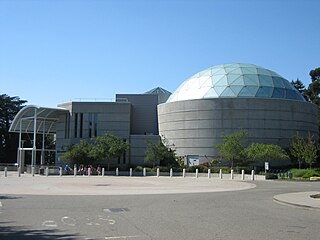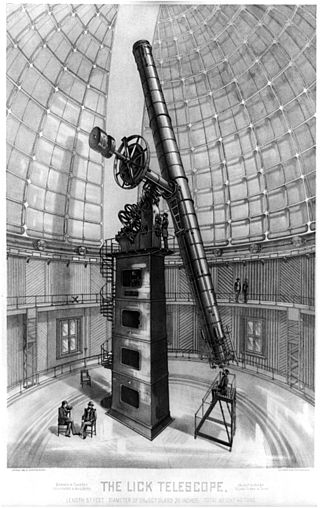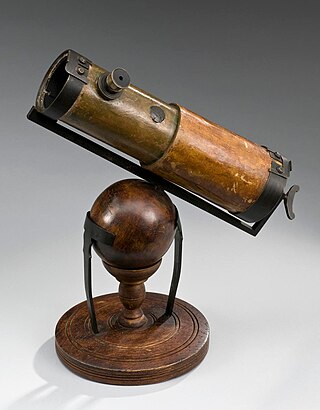This article needs additional citations for verification .(October 2023) |
The Clarke Observatory is located on the University of Mount Union campus in Alliance, Ohio. [1]
This article needs additional citations for verification .(October 2023) |
The Clarke Observatory is located on the University of Mount Union campus in Alliance, Ohio. [1]
Originally built for private use, the observatory was sold to Elmer Harrold, another private owner, who donated to Mount Union College upon the graduation of his daughter from the college. [2] A new observatory was built on campus to house the observatory in 1923 and outfitted with the telescope from the first Clarke Observatory. The second observatory was demolished in 1969 and the telescope moved to East Hall at Mount Union College.
First Observatory
Second Observatory
Third Observatory

Yerkes Observatory is an astronomical observatory located in Williams Bay, Wisconsin, United States. The observatory was operated by the University of Chicago Department of Astronomy and Astrophysics from its founding in 1897 until 2018. Ownership was transferred to the non-profit Yerkes Future Foundation (YFF) in May 2020, which began millions of dollars of restoration and renovation of the historic building and grounds. Yerkes re-opened for public tours and programming in May 2022. The April 2024 issue of National Geographic magazine featured a story about the Observatory and ongoing work to restore it to relevance for astronomy, public science engagement and exploring big ideas through art, science, culture and landscape. The observatory offers tickets to programs and tours on its website.

One of the earliest recorded telescope-like tools is that of the first century Jewish sage, Rabban Gamliel. The Talmud records his tube shaped tool that enabled him to see great distances.

A refracting telescope is a type of optical telescope that uses a lens as its objective to form an image. The refracting telescope design was originally used in spyglasses and astronomical telescopes but is also used for long-focus camera lenses. Although large refracting telescopes were very popular in the second half of the 19th century, for most research purposes, the refracting telescope has been superseded by the reflecting telescope, which allows larger apertures. A refractor's magnification is calculated by dividing the focal length of the objective lens by that of the eyepiece.

Ladd Observatory is an astronomical observatory at Brown University in Providence, Rhode Island. Founded in 1891, it was primarily designed for student instruction and research. The facility operated a regional timekeeping service. It was responsible for the care and calibration of clocks on campus including one at Carrie Tower and another that rang the class bell at University Hall. Meteorological observations were made there from the time the building opened using recording weather instruments.

Hamburg Observatory is an astronomical observatory located in the Bergedorf borough of the city of Hamburg in northern Germany. It is owned and operated by the University of Hamburg, Germany since 1968, although it was founded in 1825 by the City of Hamburg and moved to its present location in 1912. It has operated telescopes at Bergedorf, at two previous locations in Hamburg, at other observatories around the world, and it has also supported space missions.

The Warner and Swasey Observatory is the astronomical observatory of Case Western Reserve University. Named after Worcester R. Warner and Ambrose Swasey, who built it at the beginning of the 20th century, it was initially located on Taylor Road in East Cleveland, Ohio, USA. The observatory, which at that time housed a 9.5-inch (24 cm) refractor, was donated in 1919 to the Case School of Applied Science. The newer 24-inch (61 cm) Burrell Schmidt telescope was built in 1939.

The James Lick Telescope is a refracting telescope built in 1888. It has a lens, which is 91 centimetres (36 in) in diameter—a major achievement in its day. The instrument remains in operation and public viewing is allowed on a limited basis. Also called the "Great Lick Refractor" or simply "Lick Refractor", it was the largest refracting telescope in the world until 1897, and now ranks third, after the 40-inch refractor at the Yerkes Observatory and the Swedish 1-m Solar Telescope. The telescope is located at the University of California's Lick Observatory atop Mount Hamilton at an elevation of 1,283 metres (4,209 ft) above sea level. The instrument is housed inside a dome that is powered by hydraulic systems that raise and lower the floor, rotate the dome and drive the clock mechanism to track the Earth's rotation. The original hydraulic arrangement still operates today, with the exception that the original wind-powered pumps that once filled the reservoirs have been replaced with electric pumps. James Lick is entombed below the floor of the observing room of the telescope.

Chabot Space and Science Center, located in Oakland, California, is a center for learning in Earth and space science, which features interactive exhibits, planetariums, a large screen theater, hands-on activities, and three powerful telescopes.

The Warner & Swasey Company was an American manufacturer of machine tools, instruments, and special machinery. It operated as an independent business firm, based in Cleveland, from its founding in 1880 until its acquisition in 1980. It was founded as a partnership in 1880 by Worcester Reed Warner (1846–1929) and Ambrose Swasey (1846–1937). The company was best known for two general types of products: astronomical telescopes and turret lathes. It also did a large amount of instrument work, such as equipment for astronomical observatories and military instruments The themes that united these various lines of business were the crafts of toolmaking and instrument-making, which have often overlapped technologically. In the decades after World War II, it also entered the heavy equipment industry with its acquisition of the Gradall brand.

Alvan Clark & Sons was an American maker of optics that became famous for crafting lenses for some of the largest refracting telescopes of the 19th and early 20th centuries. Founded in 1846 in Cambridgeport, Massachusetts, by Alvan Clark, and his sons George Bassett Clark (1827–1891) and Alvan Graham Clark (1832–1897). Five times, the firm built the largest refracting telescopes in the world. The Clark firm gained "worldwide fame and distribution", wrote one author on astronomy in 1899.

The University of Illinois Astronomical Observatory, located at 901 S. Mathews Avenue in Urbana, Illinois, on the campus of the University of Illinois Urbana–Champaign, was built in 1896, and was designed by Charles A. Gunn. It was listed on the National Register of Historic Places on November 6, 1986, and on December 20, 1989, was designated a National Historic Landmark.

Fuertes Observatory is an astronomical observatory located on the North Campus of Cornell University in Ithaca, New York. The observatory was designed by L.P. Burnham, Cornell Professor of Architecture and completed in fall of 1917. It was originally used by the Civil Engineering Department as an instructional field office for navigation and surveying. Today, the observatory is primarily used for public outreach, welcoming over two thousand visitors per year with open houses on clear Friday nights.

The Dearborn Observatory is an astronomical observatory located on the Evanston campus of Northwestern University. The observatory was originally constructed in 1888, through an agreement between the university and the Chicago Astronomical Society. In the summer of 1939, Dearborn Observatory had to be moved to make way for the construction of the Technological Institute.

The Kenwood Astrophysical Observatory was the personal observatory of George Ellery Hale, constructed by his father, William E. Hale, in 1890 at the family home in the Kenwood section of Chicago. It was here that the spectroheliograph, which Hale had invented while attending MIT, was first put to practical use; and it was here that Hale established the Astrophysical Journal. Kenwood's principal instrument was a twelve-inch refractor, which was used in conjunction with a Rowland grating as part of the spectroheliograph. Hale hired Ferdinand Ellerman as an assistant; years later, the two would work together again at the Mount Wilson Observatory.

The first reflecting telescope built by Sir Isaac Newton in 1668 is a landmark in the history of telescopes, being the first known successful reflecting telescope. It was the prototype for a design that later came to be called the Newtonian telescope. There were some early prototypes and also modern replicas of this design.

McMillin Observatory was an astronomical observatory built around 1895 on the campus of Ohio State University. Named after Emerson McMillin and operated by the university, the observatory closed in 1968 and its telescope later moved to Ballreich Observatory. The observatory was equipped with photographic cameras, a filar micrometer, and a custom Brashear spectroscope. The observatory had two main focuses, education and at least one astronomic scientific research study focus.

An aerial telescope is a type of very long focal length refracting telescope, built in the second half of the 17th century, that did not use a tube. Instead, the objective was mounted on a pole, tree, tower, building or other structure on a swivel ball-joint. The observer stood on the ground and held the eyepiece, which was connected to the objective by a string or connecting rod. By holding the string tight and maneuvering the eyepiece, the observer could aim the telescope at objects in the sky. The idea for this type of telescope may have originated in the late 17th century with the Dutch mathematician, astronomer and physicist Christiaan Huygens and his brother Constantijn Huygens, Jr., though it is not clear if they actually invented it.

Great refractor refers to a large telescope with a lens, usually the largest refractor at an observatory with an equatorial mount. The preeminence and success of this style in observational astronomy defines an era in modern telescopy in the 19th and early 20th century. Great refractors were large refracting telescopes using achromatic lenses. They were often the largest in the world, or largest in a region. Despite typical designs having smaller apertures than reflectors, great refractors offered a number of advantages and were popular for astronomy. It was also popular to exhibit large refractors at international exhibits, and examples of this include the Trophy Telescope at the 1851 Great Exhibition, and the Yerkes Great Refractor at the 1893 World's Fair in Chicago.

The Hume Cronyn Memorial Observatory is a public astronomical observatory located on the campus of the University of Western Ontario, in London, Ontario, Canada.

The Greenwich 28-inch refractor is a telescope at the Royal Observatory, Greenwich, where it was first installed in 1893. It is a 28-inch ( 71 cm) aperture objective lens telescope, otherwise known as a refractor, and was made by the telescope maker Sir Howard Grubb. The achromatic lens was made Grubb from Chance Brothers glass. The mounting is older however and dates to the 1850s, having been designed by Royal Observatory director George Airy and the firm Ransomes and Simms. The telescope is noted for its spherical dome which extends beyond the tower, nicknamed the "onion" dome. Another name for this telescope is "The Great Equatorial" which it shares with the building, which housed an older but smaller telescope previously.